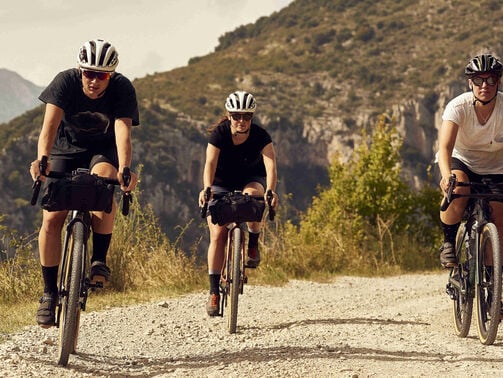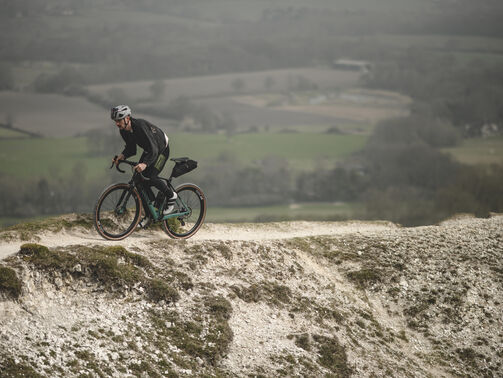Cyclocross vs gravel Bike: What are the differences?
In the market for a new bike and can’t decide between a cyclocross and a gravel bike? From the intensity of racing to all-day riding over mixed terrain, it’s cyclocross vs gravel bike as we break down the key differences so you can choose the right one for your adventures.

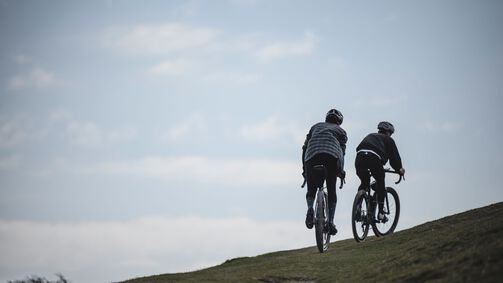
At first glance, gravel and cyclocross bikes share a similar aesthetic. However, a closer look shows their differences and the distinct riding experiences each delivers.
A good, simple rule of thumb to remember is that the original idea for a cyclocross bike, or CX bike, was purpose-designed for a single race discipline: cyclocross. Blending elements of road cycling, mountain biking and steeplechase, cyclocross races feature grass, mud, and obstacles, requiring riders to dismount and carry their bikes over barriers and inclines.
A gravel bike is optimized for all-day riding adventures over mixed terrain. This riding style is about getting away from it all on less-travelled paths, blending endurance exploration and off-road challenges.
While the two bikes share many parallels, there are clear differences when it comes to a cyclocross vs gravel bike. So, what exactly separates the cyclocross from its gravel counterpart, and how does that affect the riding experience?
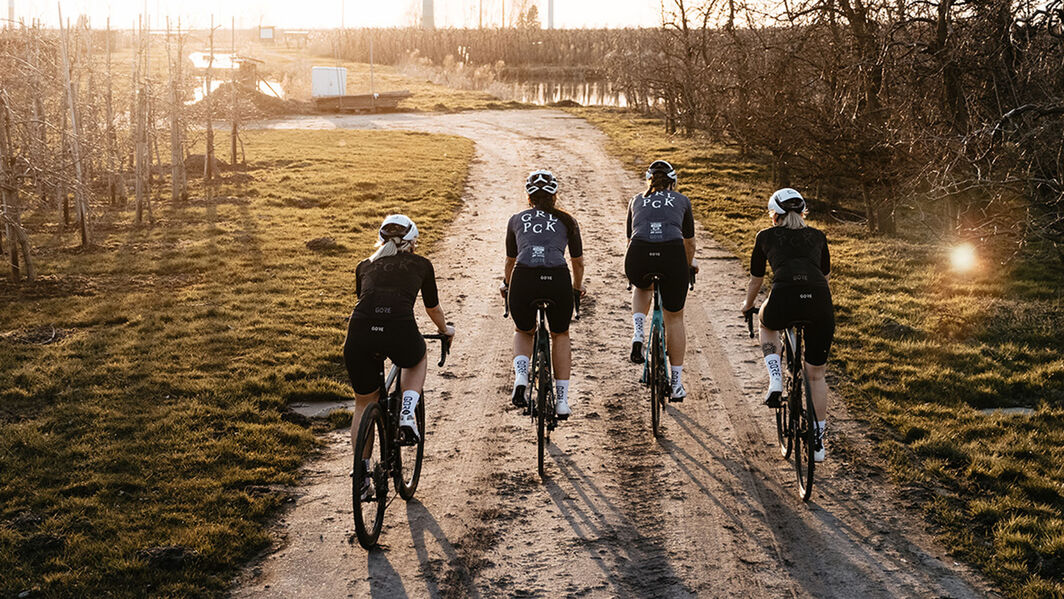
Gravel vs cyclocross bike: geometry differences
Cross bikes are made to rip around a course quickly and corner hard. But thanks to a CX bike’s geometry, cross riders feel as much at home on muddy forest paths as they do on grass or gravel.
To the naked eye, the cyclocross bike looks a lot like a road bike. However, some key aspects of a cyclocross bike's geometry contribute to a very different riding feel:
- A higher bottom bracket increases ground clearance, raising the bike’s overall center of gravity and making it easier to navigate over rough terrain.
- A tighter wheelbase and lower stack height contribute to the bike's agility, making it nimble and responsive—ideal for quick maneuvers and tight turns.
- The top tube’s mountain bike-like angle and slacker headtube angle are designed for stability and offroad handling on diverse terrains.
- Cyclocross bikes usually have external cable routing on the top tube for convenience and to reduce the risk of damage when encountering water, mud or debris.
- The top tube is flattened for easier shouldering, and a lightweight frame, such as carbon, makes it easier to carry the bike during races or when facing obstacles that cannot be ridden over.
Looking for road bikes? Take a look at our road bike buyers guide.
Gravel bikes are designed for comfort, stability and versatility over long distances on varied surfaces. The geometry of a gravel bike ensures stable handling on everything from gravel paths to rough backroads. We explained everything about gravel bikes in a guide if you are buying your first one, but here are some key features:
- A longer wheelbase and chainstays on gravel bikes ensure enhanced control, crucial for navigating rough terrains.
- A slacker head tube angle contributes to the bike's stability, making it well-suited for all-road bikes for adventurous off-road cycling and challenging landscapes.
- A taller stack height promotes an upright riding position, prioritizing comfort on long rides.
- Gravel bikes may feature front suspension or suspension in the seat post to absorb impact over longer distances and more challenging terrain.
The specific geometry of cyclocross and gravel bikes underpins their riding experiences: cyclocross bikes are optimized for speed and handling on complex terrains. Gravel bikes have more features for comfort and stability on longer adventures—wherever you are in the world.

Tires and tire clearance distinctions
Cyclocross tires feature a good tread pattern, and a width of 32 mm to 35 mm provides optimum grip on the terrain. For cyclocross racing, the tire width is limited to a maximum of 33 mm (a standard set by UCI, the sport’s governing body).
Cyclocross bikes are generally equipped with 28-inch rims (700c). The tire clearance is designed to allow for mud shedding but is not as wide as gravel bikes, limiting the option for wider tires.
How does this compare to tires on a gravel bike?
The tires on a gravel bike all have tread, however, the width varies from a sporty 30mm to a robust 50mm. Wide tires generally make gravel bikes more comfortable but can make the handling feel sluggish and increase rolling resistance.
Gravel bikes typically accommodate a broader range of wheel sizes compared to cyclocross bikes. The standard size is 28” rims (700c), although some of our smaller-sized models can come spec’d with 650b rims. This is done to ensure handling and ride characteristics remain unchanged regardless of size.
Gravel bike vs cyclocross bike: variances in equipment
Cyclocross bikes were initially designed for a very specific purpose—races that typically only cover 10-20 miles and only last 30 to 90 minutes. With this high-intensity focus, CX bikes typically feature minimalistic frames with limited mounting points for racks or fenders in pursuit of lightness and agility.
Designed with adventure in mind, gravel bikes come with numerous mounts for mud guards or luggage racks. This makes them ideal touring bikes in all weather or suited for true off-the-grid bikepacking.
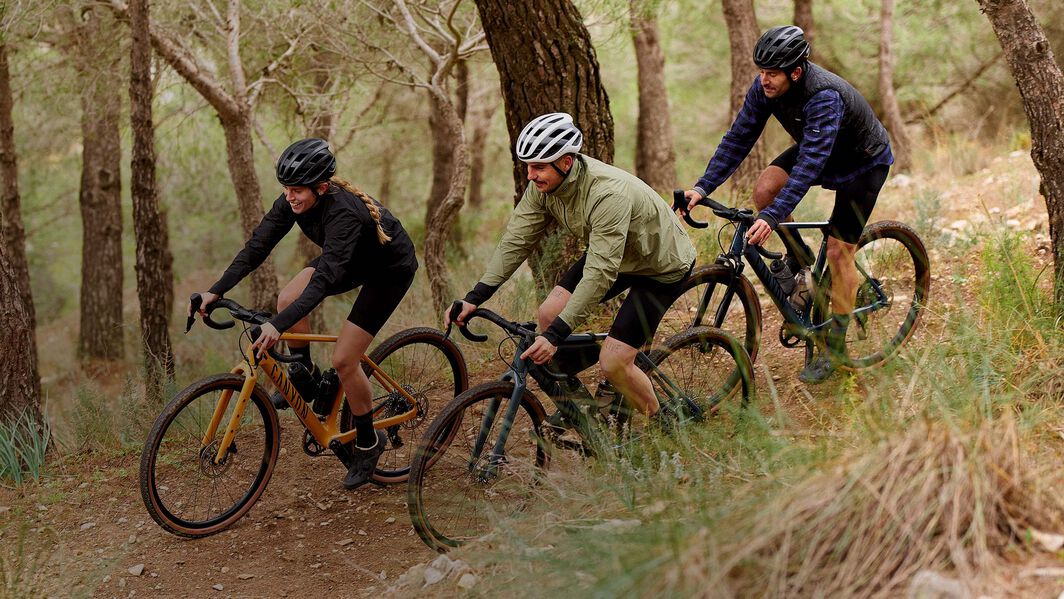
Variances in drive chain
When it comes to cyclocross vs gravel bike, there can be big differences in the drive chain. Cyclocross bikes are geared for a short race with punchy climbs out of the saddle. High gears are out of the question on this type of bike; smaller gear ratios with finely graduated gears are the better choice for changing terrain.
With two front chainrings, 46/36, 44/34 and 42/32 are common on CX bikes; on the rear wheel, 11-28 or 11-32 cassettes are usually found. Single cranks have also become popular on cyclocross bikes. They save weight and you're less likely to drop your chain during a crucial part of a race.
Gravel bikes offer the complete range of gearing options to accommodate everything from flat roads to steep climbs: road bike gearing (2×11-speed with compact crank 50/34, sub-compact gearing 2×11-speed with 46/36 or even smaller) but also the increasingly popular one-by (1x) drivetrains have become commonplace on gravel bikes.
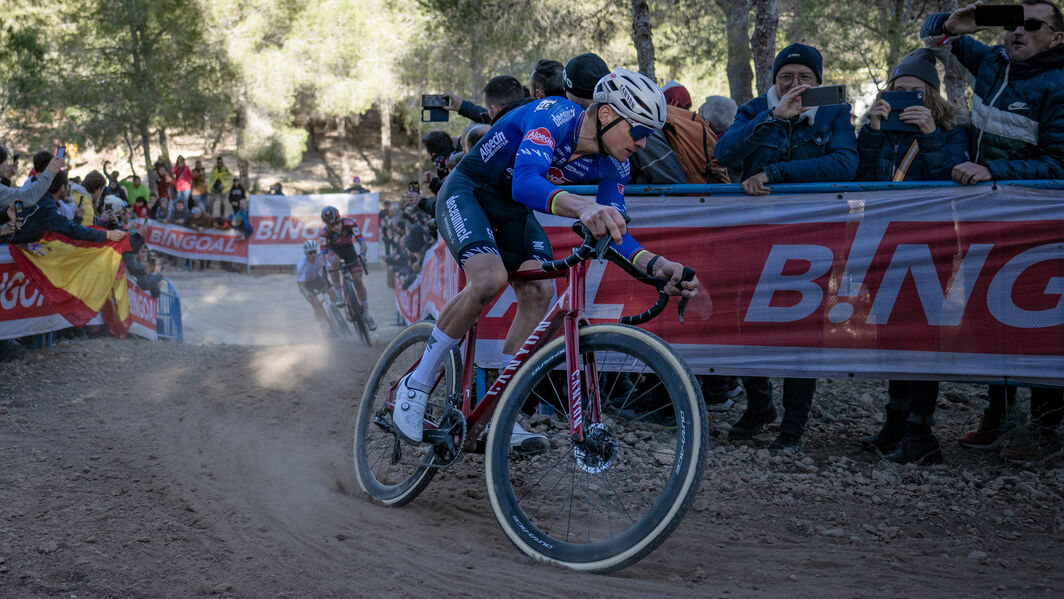
Finishing kit differences in CX vs gravel bikes
The finishing kit on a bike includes components such as the handlebars and stems, seatpost, saddle and pedals. These parts significantly influence the comfort, handling and overall riding experience.
Cyclocross bikes prioritize performance, with a finishing kit designed to support the demands of cyclocross racing—speed, agility and quick transitions. Here are some typical finishing kit features of cyclocross bikes:
- Narrower handlebars to navigate through tight spaces and improve bike handling in race conditions.
- Lighter and more performance-oriented saddles that allow for quick dismount and remounts.
- Longer stems for a more aggressive riding posture and improved aerodynamics and power transfer during races.
Gravel bikes focus on comfort and versatility for long rides on mixed surfaces, featuring components that enhance control and reduce fatigue. Here are the typical finishing kit features of a gravel bike:
- Wider handlebars with a flare outwards at the drops. As well as a more comfortable hand position, the handlebar design provides greater stability on rough terrain.
- Saddles on gravel bikes are designed for comfort over long distances. They may feature a more ergonomic shape or additional padding to support a variety of riding positions.
- The stems on gravel bikes may be slightly shorter to promote a more upright riding position, enhancing comfort and control on varied terrain.
A cyclocross vs gravel bike finishing kit reflects their unique design philosophy: cyclocross bikes are built for the intensity of racing, while gravel bikes are tailored for endurance and comfort on mixed terrains. These differences ensure that each bike type meets the specific needs of its riders.
CX bike vs gravel bike: crafted for varied purposes and terrains
Gravel and cyclocross bikes, though similar in appearance, are engineered with distinct purposes and terrains in mind. The difference in design philosophy extends beyond frame geometry or finishing kit, to the essence of the riding experiences they offer.
Cyclocross bikes
Cyclocross bikes are precision crafted for the intensity of cyclocross racing, characterized by fast-paced events on closed circuits that mix mud, sand, grass and obstacles, requiring riders to dismount and carry their bike.
Their more aggressive geometry enhances handling when navigating tight turns. A narrow tire clearance is to comply with race regulations with a focus on speed and less emphasis on comfort. The gearing setup is designed for the burst efforts needed, with options for quick shifts to maintain optimal cadence.
Gravel Bikes
Gravel bikes are designed to tackle a broad spectrum of conditions. The hallmarks of a gravel bike are a relaxed geometry with a focus on stability on loose surfaces and comfort during long rides.
Gravel bikes usually feature a wider tire clearance to accommodate a range of tire sizes for different terrains. As well as plenty of mounting options for racks and bikepacking bags, they have a wide gear range that can tackle steep climbs, fast descents and the unpredictability of gravel roads.
Canyon Cyclocross Bikes
Discover our legendary Inflite, piloted to multiple World Champion titles.
View allCan my cyclocross bike handle gravel riding?
Before the gravel bike boom, CX bikes were the do-it-all bike and perfectly capable of handling gravel riding. However, you may need to make minor adjustments like moving your seat height and maybe raising or swapping the stem for a more upright position (just keep in mind that the bike’s frame geometry will set limits).
Given cyclocross tires are 33 - 35mm wide, if you’re not confident on slimmer tires, a bike that can fit wider tires, like a gravel bike, might be more suitable. You’ll also need to change your tires if your regular CX tires are designed for mud.
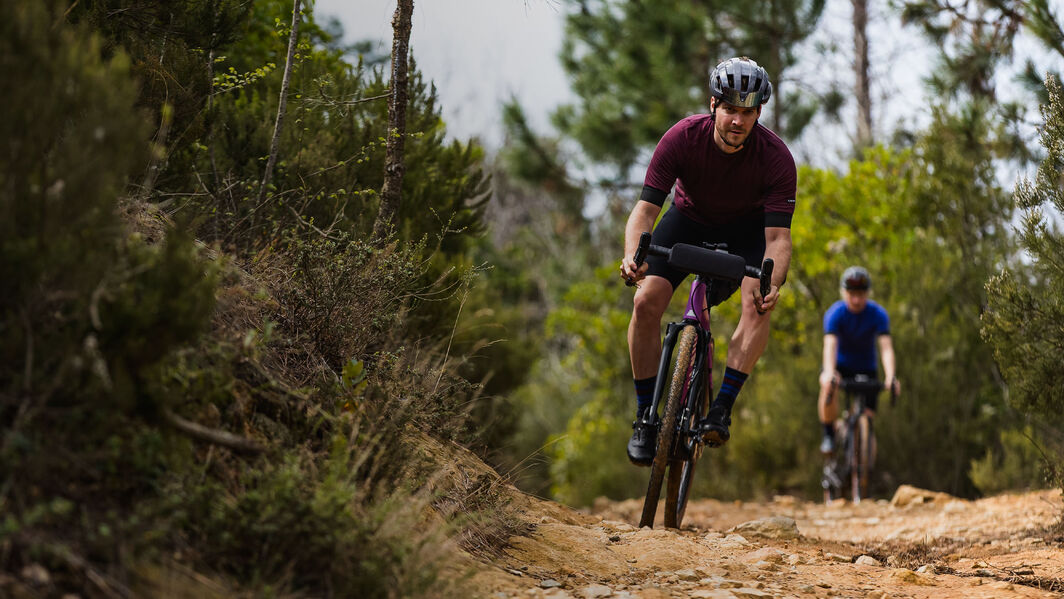
Is cyclocross racing possible with my gravel bike?
There’s a massive amount of overlap between the cyclocross and gravel bike categories. When it comes to gravel bike vs cyclocross for a race, many would argue that unless you’re going pro, you can get by with a gravel bike.
One thing to look out for is that the gravel bike will have a lower bottom bracket. This might make hopping obstacles or riding off-camber on a cyclocross track trickier. Some gravel bikes may have sloping top tubes—meaning less shoulder clearance—which can be a challenge if you are shouldering your bike for longer runups.
The only key weakness of a gravel bike in a cyclocross race might be related to handling and uphills. Gravel bikes often aren’t as agile as their CX counterparts.
Conclusion: cyclocross vs gravel bike - which is better?
Cyclocross bike or gravel bike? It’s no easy decision, but a good way to think about it is this: are you more likely to take up bikepacking and touring or cyclocross racing?
Both gravel and CX bikes are multi-surface, i.e., capable of tackling dirt, grass, mud, road and various terrains. A cross bike will have a geometry better suited to racing but generally lacks the mounting points to attach accessories like bags, racks and fenders. A gravel bike will have a wider gear range, ensuring riders can maintain an optimal cadence and power across varying terrains, from steep climbs to fast descents.
When it comes to cyclocross vs gravel bike, deciding which bike suits you best is not easy. Think carefully about how you use your bike most often and how important everyday usability and comfort features are to you. Once you have made your decision, you can explore the appropriate category of Canyon. There you will find bikes with high-quality components to suit every taste. You even have the right to return the bike within 30 days if you don't like it.
Did this article help?
Thank you for your feedback
